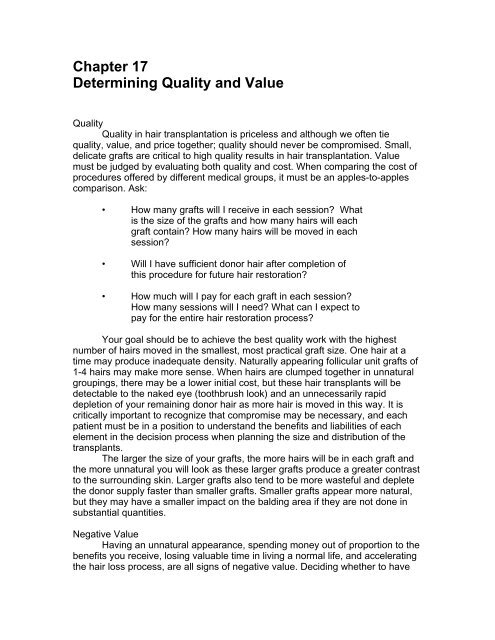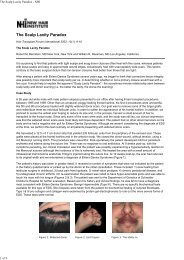The Patient's Guide to Hair Restoration - New Hair Institute
The Patient's Guide to Hair Restoration - New Hair Institute
The Patient's Guide to Hair Restoration - New Hair Institute
You also want an ePaper? Increase the reach of your titles
YUMPU automatically turns print PDFs into web optimized ePapers that Google loves.
Chapter 17<br />
Determining Quality and Value<br />
Quality<br />
Quality in hair transplantation is priceless and although we often tie<br />
quality, value, and price <strong>to</strong>gether; quality should never be compromised. Small,<br />
delicate grafts are critical <strong>to</strong> high quality results in hair transplantation. Value<br />
must be judged by evaluating both quality and cost. When comparing the cost of<br />
procedures offered by different medical groups, it must be an apples-<strong>to</strong>-apples<br />
comparison. Ask:<br />
• How many grafts will I receive in each session? What<br />
is the size of the grafts and how many hairs will each<br />
graft contain? How many hairs will be moved in each<br />
session?<br />
• Will I have sufficient donor hair after completion of<br />
this procedure for future hair res<strong>to</strong>ration?<br />
• How much will I pay for each graft in each session?<br />
How many sessions will I need? What can I expect <strong>to</strong><br />
pay for the entire hair res<strong>to</strong>ration process?<br />
Your goal should be <strong>to</strong> achieve the best quality work with the highest<br />
number of hairs moved in the smallest, most practical graft size. One hair at a<br />
time may produce inadequate density. Naturally appearing follicular unit grafts of<br />
1-4 hairs may make more sense. When hairs are clumped <strong>to</strong>gether in unnatural<br />
groupings, there may be a lower initial cost, but these hair transplants will be<br />
detectable <strong>to</strong> the naked eye (<strong>to</strong>othbrush look) and an unnecessarily rapid<br />
depletion of your remaining donor hair as more hair is moved in this way. It is<br />
critically important <strong>to</strong> recognize that compromise may be necessary, and each<br />
patient must be in a position <strong>to</strong> understand the benefits and liabilities of each<br />
element in the decision process when planning the size and distribution of the<br />
transplants.<br />
<strong>The</strong> larger the size of your grafts, the more hairs will be in each graft and<br />
the more unnatural you will look as these larger grafts produce a greater contrast<br />
<strong>to</strong> the surrounding skin. Larger grafts also tend <strong>to</strong> be more wasteful and deplete<br />
the donor supply faster than smaller grafts. Smaller grafts appear more natural,<br />
but they may have a smaller impact on the balding area if they are not done in<br />
substantial quantities.<br />
Negative Value<br />
Having an unnatural appearance, spending money out of proportion <strong>to</strong> the<br />
benefits you receive, losing valuable time in living a normal life, and accelerating<br />
the hair loss process, are all signs of negative value. Deciding whether <strong>to</strong> have



